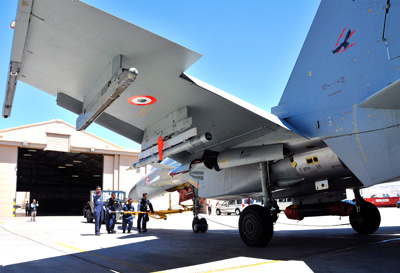INDIAN ARMED FORCES CHIEFS ON OUR RELENTLESS AND FOCUSED PUBLISHING EFFORTS

The insightful articles, inspiring narrations and analytical perspectives presented by the Editorial Team, establish an alluring connect with the reader. My compliments and best wishes to SP Guide Publications.

"Over the past 60 years, the growth of SP Guide Publications has mirrored the rising stature of Indian Navy. Its well-researched and informative magazines on Defence and Aerospace sector have served to shape an educated opinion of our military personnel, policy makers and the public alike. I wish SP's Publication team continued success, fair winds and following seas in all future endeavour!"

Since, its inception in 1964, SP Guide Publications has consistently demonstrated commitment to high-quality journalism in the aerospace and defence sectors, earning a well-deserved reputation as Asia's largest media house in this domain. I wish SP Guide Publications continued success in its pursuit of excellence.
- A leap in Indian aviation: Prime Minister Modi inaugurates Safran's Global MRO Hub in Hyderabad, Calls It a Milestone
- All about HAMMER Smart Precision Guided Weapon in India — “BEL-Safran Collaboration”
- India, Germany deepen defence ties as High Defence Committee charts ambitious plan
- True strategic autonomy will come only when our code is as indigenous as our hardware: Rajnath Singh
- EXCLUSIVE: Manish Kumar Jha speaks with Air Marshal Ashutosh Dixit, Chief of Integrated Defence Staff (CISC) at Headquarters, Integrated Defence Staff (IDS)
- Experts Speak: G20 Summit: A Sign of Global Fracture
Debunking Delusions

Even if one were to dismiss the demeaning comments of the USAF pilot as mere personal opinion, the observations nevertheless warrant a close, professional scrutiny.
There’s no denying the niggling feeling of annoyance. Although the Indian Air Force (IAF) deliberately chose not to take umbrage at the rogue comments of a USAF Lieutenant Colonel, an F-15 pilot, either through diplomatic channels or service-to-service network, it is obvious that the IAF is decidedly peeved.
Apologising profusely, a letter from the US Air Force (USAF) Public Relations Officer of Exercise Red Flag addressed to the IAF’s Red Flag team leader clarified that the comments made in the video were the personal opinion of the officer and did not reflect USAF views. That is, however, cold comfort for some of the participants who feel angry and irritated. Seeking to smooth ruffled feathers, IAF Vice Chief Air Marshal P.V. Naik, who, incidentally, visited Nellis Air Force Base to witness the exercise, succinctly dismissed the whole video affair as too demeaning (but highly trivial) to take up in a big way. Nevertheless, the Lieutenant Colonel’s comments on the following issues warrant a close, professional scrutiny:
• Su-30’s capabilities in close combat and poor tactics adopted by Indian pilots
• Poor sensors/networking capabilities of Su-30 leading to lack of proper Situational Awareness, resulting in a large number of cases of fratricide
• Low reliability of Su-30 Tumansky engines and their susceptibility to foreign object damage leading to unrealistic Standard Operating Procedures.
On the very outset, the Red Flag exercise was a brilliant learning experience for all the participants, more so for the IAF which was participating for the first time in a gruelling world class exercise which has aptly earned the sobriquet of being the Mother of all Air Exercises. Complementarily, for the other participants at the exercise—the French, South Korean and the US air forces—to train with a platform such as the Sukhoi Su-30 MKI was quite a telling experience. This had a lot to do not just with the formidable jet but also with the force operating the fighter, the IAF, that has earned a reputation as an innovative operator of fast jets. Now, let’s cut to the chase.
Thrust Vectoring vs Conventional
In an aircraft with thrust vectoring (TV), the instantaneous turn rate can go up to 50 deg/sec and, in a turn, as the speed drops, turn rate (sustained) increases further. In a conventional aircraft, sustained rate of turn would be less than what can be generated instantaneously but even that would be no match to the TV aircraft.
Further, in a conventional aircraft, combat potential reduces as the speed drops and to avoid reaching stall, the aircraft recovers on auto with fly-by-wire controls. On the other hand, with thrust vectoring capability, an aircraft can be controlled even at the point of stall and even at these low speeds, it can be turned and made to point at the adversary in any condition of flight to take a shot.





